How to apply the 80/20 rule to earn more, work less, and dominate
Posted: Thursday, May 17, 2012 by Tyler Durden in Labels: knowledge , productivityHow to apply the 80/20 rule to earn more, work less, and dominate
Today, learn how to apply the 80/20 rule to eliminate meaningless work from your life — and focus on what really matters — to earn more, work less, and spend time doing the things you love.

- How to work 2 fewer hours/day
- How to double your salary (at age 26)
- How to take a $12,000 around-the-world trip for $297
- How somebody named Jamie earned $11,000/month working 20 hours/week
What do all of those have in common?
The 80/20 rule.
Most of us complain how busy we are, whether it’s with work, our family, or just the basic upkeep of life. Yet there are others — who have exactly the same amount of hours as we do — who do remarkable things. How?
In fact, if we actually analyze our time spent on any given week, we’d find that the vast majority of the actions we take have very little impact.
A bleak conclusion? Perhaps. But if you can tweak your actions and focus on the actions that really matter, you can leapfrog your peers and live a remarkable life.
For example, people often believe that they can do everything when it comes to personal finance. Pay off debt! Save more! Invest! Stop spending on lattes! Earn more! Shop frugally! Make your own dinner! JUST DO IT!! AAAAAAAAAHHHHHH!!!!!!
The truth is, we are cognitive misers and we have limited cognition and attention. That’s why it’s critical to focus on the most IMPORTANT things, rather than everything. That’s why I write extensively about automating your finances. It’s also use the Tripod of Stabilityin my life.
Below, in an extensive guest post, Tyler Tervooren shows you several examples how to focus on the things that matter (along with some fascinating charts).
I have to add one thing. When Tyler pitched writing a guest post for me, he had a little too many examples of me, even when you factor in my extremely large ego. I sent it back and told him to tone down the praise. So below is the edited version. It’s like hearing your own voice on a recording — uncomfortable and weird. But the rest of the material is gold, so check it out.
Tyler, take it away…
Applying the 80/20 Rule to earn more, work less, and dominate
Tyler Tervooren tests the boundaries of reality and writes for a team of highly skilled risk takers atAdvanced Riskology. You can follow him on twitter at @tylertervooren.
Do you know what people like Ramit, Tim Ferriss, and Erica Douglass do that you don’t?
Nothing.
Yep, nothing. When it comes to day to day living, these guys are just like you and me. Ramit had to create a budget before he realized he was spending 70% of his money on food. Tim doesn’t always pick the perfect investments. Erica has bad days just like the rest of us.
Most people don’t see it like that, though. They just see a couple of people who somehow worked harder, got a little bit lucky, and made it further than them.
Most of us think Ramit, Tim, & Erica have just straight up beaten us at life. Well, they have, actually, but not by working harder or getting lucky.
You see, there’s this thing about humans that everyone knows but not very many people acknowledge and even fewer actually take advantage of:
They’re lazy.
Human beings are inherently lazy and the few people that take it upon themselves to rise above the bar that’s set, well, pretty darn low, enjoy a lot of benefits for doing so.
Ramit, Tim, Erica – they don’t really do anything different than the rest of us. They just do the things that actually matter a lot better.
And that’s the ironic part about this universal truth. While I certainly wouldn’t call any of them lazy, in the end, these guys enjoy the benefit of less work because they’ve improved their life processes so dramatically that they don’t have to work nearly as hard to kick ass anymore.
Over time, they’ve built up what I call “compounding awesomeness” while the rest of us stick to comfortable things that don’t work or reinvent the wheel every week with no idea if what we’re reinventing actually works or not.
Don’t believe me? Try this exercise for an example of what I’m talking about:
Pick out your 5 closest friends that say they care about personal finance and ask them how many hours they spent last week optimizing their budget or their 401k allocation. Then ask how many hours they spent watching TV.
Let’s move on.
Truth is, what Tim, Erica, and Ramit do that’s propelled them above the rest doesn’t take genius, but it does take work and sustained effort. It takes a little bit of measurement every day and an undying focus on improving things that work and dropping things that don’t.
It takes some creativity. It takes some ingenuity. Most of all, it takes some strategy. Here are few strategies for you to chew on.
Strategy #1: Ctrl+Z 80% of your life
Ah, the good ol’ 80/20 rule. Maybe you know it as Pareto’s Principle, which demonstrates that in most things you do, 80% of your results come from 20% of your efforts. Pretty cool.

But not so cool? It also means that 20% of your results come from 80% of your efforts.

Do you see the incredible opportunity here? You can do more than just eliminate 80% of all your hard work; you can take the remaining 20% and scale up to even better results.
But what the hell does that even mean?
Let’s say you’ve just started a side gig as a freelance dog walker and you charge $20 per dog for a 20-minute walk. Maybe you’ve even kicked ass and gotten yourself 10 clients.
Pretty soon you realize that 8 of your clients have just one dog and are paying you $20 a day while the other 2 each own a dog compound with 10 dogs a piece. They’re each paying $200 to walk the pooches.
A 20-minute walk is a 20-minute walk whether you’ve got 1 on a leash or 10, right? Your dog compound clients are making you far more money and using up much less of your time than the single dog owners. You want more clients like that, but you’re exhausted and don’t have time for them.
So what do you do?
You freakin’ drop all 8 of those single dog owners, quit taking new clients with only one dog and you start looking for just one more client that has at least 8. She’s harder to find, but you’ve got plenty of time now because you just dropped 80% of your commitments and didn’t lose much.
And you don’t have to stop there. You can keep looking for clients with more and more dogs and dropping the smaller ones. This is what we’re talking about:

Let’s take a second to look at some real-life examples.
How Jamie makes $11,000/month working 20 hours/week
Just a few years ago, Jamie was working full-time, making decent money, and hating her job like any good American. Then, she had a baby.
Now, I don’t know anything about these “tiny humans,” so I had to take Jamie’s word that having one changes your life. It changed hers anyway, and she decided to quit her job to start her own business and only work part time so that she could be the mom she always wanted to be.
She also decided that she didn’t really want to give up much money.
Now, cutting your hours down by 60% and maintaining your income is completely possible (It’s Tim Ferriss’ claim to fame after all), but it doesn’t just happen.
Jamie had to take a super hard look at how she did her work and find the little bits of her coaching business that were working well for her – the 20% – and leverage the hell out of them so that she could flat out stop doing all the little stuff that was taking up her time and giving her little in return – the 80%.
After looking at the numbers for her business, it was pretty obvious that going to networking events wasn’t bringing in many clients (sound familiar?), but her limited speaking engagements were doing great. Rather than try even harder to make the networking events work (almost always a bad idea) she quit going to them entirely and started focusing on doing more speaking, which took up even less time.
She didn’t stop there, though. Jamie also decided to quit traveling to meet her local clients so that she could spend less time helping more people.
From Jamie:
Early this year I decided to stop pursuing local clients since I realized traveling to networking events and my clients businesses took up many hours each week. Since I live in Maine and it takes a long time to drive anywhere, I decided that I couldn’t take up 6 of my 20 hours driving each week. I’ve since changed my local clients to over the phone.
She calls these her “bold actions” and while the business professionals out there will argue incessantly about the right or wrong way to run her business, Jamie just had her first $11,000 month.
More money + less time = Domination of the 80/20 Rule (and domination of your friends).
Why I love writing articles like this one
I’ve seen the exact same results when I do my own 80/20 analyses. I launched Advanced Riskology in June and spent the first 2 months chasing every strategy I could think of to grow it. Naturally, there were a few that worked very well and a whole bunch that didn’t.
Here’s the actual break out of where my site traffic comes from vs. how much time I spend on each promotional outlet:

Rather than spend hours every day trying to suffer through the process of keeping up with tactics that didn’t do much, I just dropped them and now spend far less time, maybe 10% of what I was before, focusing on the promotion tools that work incredibly well for me:

That’s why you’re reading this guest post today. I’ve found that writing awesome articles for huge blogs gives me one of the best returns I can get for the time involved. The only other strategy I use is interviews/media mentions that I spend about 15 minutes a day working on.
The result? Explosive growth – almost 2,000 subscribers in the first 3 months for less than 2 hours a week of “marketing.”
I’ll take that over constant frustration any day.
Strategy #2: Travel, get married or do anything else awesome… for free.
I always endeavor to be a supportive friend that doesn’t offer too much unsolicited advice, but it drives me nuts to hear people talk with near desperation in their voice about all the things they want to get out of life and then hear them dismiss it all because they assume they need Scrooge McDuck’s vault of gold to do any of it.
That’s why this strategy has to do with finding creative ways to do really expensive and extravagant stuff either cheaply or completely free. I’d be willing to bet that for every $10,000 dollar dream you have, there’s a way to do it for less than $100 if you’re willing to use your brain juice.
Will work for travel
My friend Sean Ogle got fed up with his corporate job in finance and wanted to do some traveling. When his boss turned down his proposal to work remotely, he just up and quit.
He had some savings, but not enough to make it for long with a home base in Portland, so he bought a 1-way ticket to Bangkok and set up shop over there where it’s far cheaper to live – geo-arbitrage.
Sean found a part time gig when he got over there, and after 6 months hanging out in Thailand and visiting the rest of SE Asia, he came home with the same amount of money that he left with.
Free 6-month vacation. Nice.
A worldwide adventure for $297
Next year, I’ll be flying to Africa and Eastern Europe to climb two of the tallest mountains in the world as well as run a marathon or two. Those are long flights and I’d like to be comfortable, so I’m planning to fly business class. That’s about $12,000 in airfare – not something I could afford even when I had a “great job.”
But, I’ll be flying for no more than the cost of taxes by using frequent flyer miles and some travel hacking strategies that I spend about 10 minutes or less a day learning. Things like:
- getting tons of miles for free flights through credit card offers without lowering my credit score
- booking tickets on partner airlines so that I can go anywhere with relative ease, and
- scheduling free stopovers in hub cities so that I don’t have to book multiple trips
Just to hit that point home, here’s what that looks like:

If you think your dream vacation is too expensive, you’re probably not looking in the right place yet.
Free Mickey Mouse matrimony
Just the other day I talked to a gal named Tracy that got married at Disney World (her favorite place on Earth) for free. She and her fiancé were taking a joint vacation with their families there and thought, “hell, why not just get married while we’re down there?”
Of course, for everyone else, that service costs at least $5,000 and quite a lot more if you want guests and good food. So, instead, they hired their own minister and paid his way into the park to perform the ceremony for them.
I asked Tracy how much work it took to put that together and here’s what she said:
I only mentioned it because in Disney-fan circles it’s a huge no-no and people think it can’t be done, so it just cracks me up that we did it – effortlessly. We could have done it anywhere we wanted – in a hotel, on a beach, in a pool, on a ride, etc.
When you’re willing to work a little harder and a little smarter, most of the things in life that you thought were too expensive and out of reach are actually right within your grasp.
Give it a shot if you’re inclined, but there is a downside to using this strategy: it’ll get harder and harder to listen to your friends complain about all the things they’ll never do because their excuses are insurmountable.
Speaking of working a little smarter…
Strategy #3: Become an executive by 25 and quit working so many damn hours
Enter Matt.
By 25, he’d worked his way into an executive finance position with UPS and just a few weeks ago, at the age of 26, said goodbye to that job in order to double his already fantastic salary and move to Europe for a change of pace with a certain online book retailer.
The funny thing about Matt is that you’d typically think of a guy like that as a dorky pencil pusher that spends his days in front of his desk and his nights underneath it.
Thing is, he really doesn’t work that much harder than anyone else with a little ambition. In fact, he recently told me that he works about 55 hours a week. That might seem like a lot to some, but consider that at least a few of those are at home watching sports while he chips away at new projects.
One other thing we should clear up is that Matt isn’t the heir to some business throne. It’s not like Daddy was the boss and gave him a management job when he graduated from high school.
When I met Matt in 2003, he was loading boxes into the back of a UPS truck at 2:00 in the morning.
So how did he work his way up the ladder so fast? I asked him, and here’s exactly what he said:
I focus on figuring out how systems work and where people’s motivations are coming from. Understanding how and why something works the way it does is amazingly powerful. This is my fundamental starting point for working smarter. Investing the time to build relationships, dissect processes, and asking why builds a solid platform to base all other activities off of.
Here’s a guy who makes well over $100k/year and the #1 thing he does to be effective at his job is understand people’s motivations and why they do the things they do. That really hammers home the power of psychology when it comes to earning more and mastering personal finance.
And he works in finance. How many people typically lump finance and psychology together? Hopefully a lot more now.
How much further could you get in your own career if you spent more time understanding your boss’ motivations?
How to work less every single day
Before I left the construction industry, that’s exactly the same strategy I used to cut about 2 hours out of my average workday (watch out, here comes another 80/20 anecdote). Rather than spending countless hours half-assing all the work I was supposedlyresponsible for, I just started working extra hard on the stuff that was really important andquit doing the stuff that wasn’t.
I didn’t need any permission to stop doing it. I knew that if I knocked it out of the park with the important stuff, no one would really care that the stuff at the bottom of the pile didn’t get done. And it paid off.
If you graphed my work schedule with my productivity over time, it would look like this:

And check out what Matt, our Gen Y exec, had to say when I asked him if putting in more hours is a good way to climb the corporate ladder:
My view is that the hours will not necessarily help unless they’re for the right things. I view a job position as something that you have a certain amount of resources for.The challenge with an entry-level job is that at least 50% of the work is administrative or something that others don’t fully use or understand. I see this as the opportunity area where an individual can look at these tasks and evaluate what the real purpose is and find new ways to do them more efficiently (you will also find that many can be eliminated or scaled down). Doing this will easily free up 10% of the week (4-5 hours).Now the trick is not to just do “more work”, it is to find out what your boss or team members are frustrated with at the moment and develop a plan to fix it. Keep repeating this and you will build up a reputation for doing so.
There you have it – straight from the horse’s mouth. Working hard is a fine trait to have, but if it’s the only tool in your bag, you’re wasting your time. The real breakthroughs come when you get into your boss’ and colleagues’ heads and actually find ways to fix the problems that are causing them pain.
That’s how you get somewhere fast.
Back to Being Lazy
Remember all that talk earlier about how humans are naturally lazy creatures? Well, it’s still all true, but the beauty of all this is that if you actually get off your ass and use some of these strategies, you’ll get to enjoy more laziness in the long-run, too.
That’s double domination. Not only do you get to flying jump-kick your friends in the face by living it up while they complain about never getting what they want, but by getting better at using these strategies you end up creating less work for yourself down the road by finding the most effective and efficient ways to do the stuff that’s important while everyone else keeps toiling away because “that’s the way it’s always been done.”
And that is how you beat your friends at life.*
*Of course, if you’re a half decent person, you might consider teaching them rather than rubbing it in their face.
Tyler Tervooren tests the boundaries of reality and writes for a team of highly skilled risk takers at Advanced Riskology. You can follow him on twitter at @tylertervooren.
NEXT POST: The invisible scripts that guide our lives


87 comments
Leave a commentCasual Kitchen
I am very doubtful if Richard Koch’s “The 80/20 Principle” will work. In essence, he is advising you to sell low and buy high. If you’re evaluating stock, you’re 80/20 would be understand how to read a profit and loss statement to see if the stock is profitable, undervalued, low debt, etc. then buying the stock and holding it for many years.
could you look at what are the top 5 or top 10 most common questions and issues, and then either write up the answers or create a 1-minute video tutorial to help the end users? (not sure from your post if you are supporting internal customers or external.)
2. I flipping learned something. So much fluff out there, this is the real shiznit!
3. You’re a cool dude, and Ramit, Tim and Erica too.
cheers
Michael
I use something similar with my personal training clients. They come in asking about eliminating rice from their diet while still eating junk food and not exercising. It’s far easier to get results with a few small changes to your life style than with some complicated diet that you won’t follow for more than a month.
Gal
The Yakezie
Cloud Source Network
You Exercise! Get Sponsored.